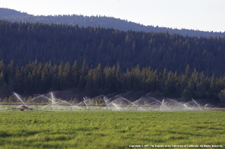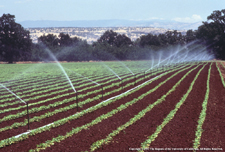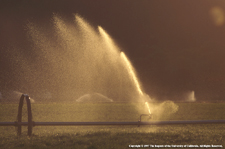Analyzing irrigation efficiency
Summary:
Spatial analysis of irrigation efficiencies is critical to implementing water conservation strategies as climate changes over time. This study utilized spatial approaches to presenting and managing data on transpiration ratios, surface soil retention and evaporation rates, and local weather conditions. With this easily manipulated data, trends can be identified and used to adjust irrigation methods to fit specific crop needs.
Investigator:
Samuel Sandoval Solis
Assistant Professor and Assistant Cooperative Extension Specialist in Water Resources
University of California, Davis
Project description:
Analyzing who is using water where and how efficiently is important to identifying potential improvements in water use. Agricultural water use efficiency is defined as the ratio of evapotranspiration of the crop grown to the water applied to that crop. The evapotranspiration rate is the amount of applied water beneficially transpired by plants, retained in the plant tissue, and evaporated from adjacent soil surfaces during a specific period of time; it varies with the type of crop. The applied water is the quantity of water applied to a specific crop per unit area, it depends on the irrigation method used, such as sub-surface, surface, sprinkler, or drip. Understanding trends in how water use efficiency has changed over time and varied in space helps to quantify how much water has been used, on which crops, and where.
Five irrigation surveys were conducted in California between 1972 and 2010. These surveys helped to improve understanding of trends in irrigation methods used for specific crops grown in California. However, the data is currently not spatially formatted, which would make it easier to display, manage, and store. Spatial information also helped us to understand how much water use efficiency varies in space and time. For example, the efficiency of sprinklers may vary from one place to another due to local conditions such as wind, temperature, or because of the type of the sprinkler. This uncertainty can be addressed by analyzing the range of efficiencies values that each irrigation method can have. Addressing the uncertainty can help to understand and inform, which methods have a more variable efficiency and in which places the efficiencies differs of their typical value.
Publications:
Sandoval-Solis, Samuel (2013) “Map of Application Efficiencies for Hydrologic Regions of the State of California”, plus entire project map library are available online.



